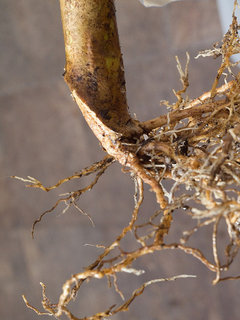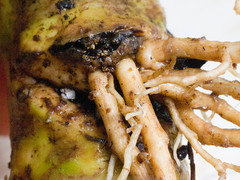new NOID orange plumeria from Hawai'i + a question about Clonex
Just got back from Maui -- I was lucky enough to pick up a fresh cutting from a NOID orange! I got it from Dan's Green House in Lahaina - they were totally awesome about it - went out and cut it for me after I saw the flower being strung onto a lei. It's called "Royal Orange", which makes me wonder if it's a seedling of Royal Hawaiian/Plastic Pink, which they also sell. (It's also labeled as their "exclusive")
It's a beautiful flower - a mix of orange, red, and yellow, but somewhat muted. The petals have some striation and texture to them. The scent is amazing - strong classic plumeria scent with some spice mixed in.
Here are a couple of pix:


So, the cutting is cut at a 45 degree angle, and needs a better callous than what's currently there (The pith is pulling away from the cambium on one side, which I'm assuming is not ideal). I was planning on recutting the bottom at a 90 degree angle and callousing it in mulch. My question is actually about Clonex rooting gel, though - do I dip the end of the cutting immediately after the latex stops flowing? Or do I wait for it to fully callous first?
Comments (14)
derft1
10 years agoI have been re-cutting at 90 degrees too. Then dipping immediately in rooting powder and letting it sit overnight with the cutting end straight up in the air. Then I callus for two weeks in mulch before potting. I have never used Clonex but I would assume it would be the same.
I still do not understand why sellers do not believe a straight cuts is better for rooting. Even when you send them the the link showing straight versus angle cut they don't want to change. Some old dogs can't be taught new tricks.
Related Professionals
Kapaa Landscape Architects & Landscape Designers · Severn Landscape Architects & Landscape Designers · Burlington Landscape Contractors · Fountain Valley Landscape Contractors · Hendersonville Landscape Contractors · Kerman Landscape Contractors · Santa Ana Landscape Contractors · Severna Park Landscape Contractors · Waltham Landscape Contractors · Waterford Landscape Contractors · West Chester Landscape Contractors · Lincoln Siding & Exteriors · Beverly Hills Siding & Exteriors · Round Rock Siding & Exteriors · Waukegan Siding & Exteriorscitizen_insane
10 years agoDerf1, you are so right. I had so many arguments with many of them. They argue that eventually the angle cut fills with roots. They could not be more wrong. I showed them evidence with 3-5 year old plumerias that they grow no more roots and most of the angle cut stays like it is with no roots. I asked them to show me just one picture of an angle cut with full roots. None could produce one.
I think the reason they defend the angle cut so hard is that a lot of them are sellers and buy their cuttings from Thailand and they come cut at an angle. Cutting them again square will result in some loses because a lot of those cuttings are in poor shape (I bought some). So they choose to root them as they are and then they have to defend them so they do not turn the people off.
George
Dar Sunset Zone 18
10 years agoWow Daogirl, that's quite a gorgeous one in my book. That orange/apricot blend is one of my favorite color blends in flowers.
derft1
10 years agoGeorge, Their attitude just blows my mind. I know you lose a little with the re-cut, but, I want a good root ball. If I lose a cutting so be it. So far I have not lost one.
AlI sellers I have corresponded with are not reselling Thai cuttings, which makes it even worse. I still send the link. Just did a little reading and I Think I will try Clonex.
Fred
Kimo
10 years agoDaogirl,
That looks like one of the Toba's varieties, and they live in Lahaina. Allen Bunch also sells it he calls it Kapalua, I listed the link to the picture and info so you can compare.
Total score, gorgeous plumie.Here is a link that might be useful: Kapalua picture
daogirl - SoCal Zone 9
Original Author10 years agoThanks for the responses!
Roxanne - Dan's was cool but small. They still have the potbellied piglets! Most of their plumeria were generic, except for Plastic Pink. The lady who was working tried to sell me on one of the PP rooted plants (which I actually want), but they were awkward center cuts and more expensive than if I ordered from Matt or Fuzzy. She then told me that they had some rarer plants, and showed me one of the leis they were working on. I liked the orange bloom and asked if I could get a cutting. Honestly, though, until I had it in hand, I wasn't sure it would happen. But I'm really glad it did!
On a weird note, some of the ABC stores carry named cuttings now! You have to dig to find one in good condition, but I also came home with a Hilo Beauty cutting. I saw HB, Donald Angus, Samoan Fluff, Celadine, Lei Plantation, and a couple of others. Not a huge selection, but better than yellow, red, white, and rainbow!
Musaboru- thanks!! I have a soft spot for the oranges and apricots, too. Hope I don't kill this cutting. LOL
Freak - thanks for the info - it does look really close. I was hoping it might be something from the Tobas! But I'm happy either way!
Kimo
10 years agoDaogirl,
Well Dan probably knows the Tobas as most of the Hawaiians that have the same hobbies and live in the same town seem to know each other and share the aloha with each other (cuttings/plants/seeds). Back in the 1970's, my uncle in Hawaii told me that there were not a lot of nurseries, that most people just shared cuttings, plants, keikis etc. So I would bet money, as unique as your plumie looks with the coloring and streaks that it is a toba plumeria. You may want to call or email Dan and ask him if it came from the Toba's.Dan's Greenhouse has been around forever now in Maui. I bought a small Singapore White from him in 2001, it was pricy for what it was as SW is all over the place in Hawaii, aka you can get a cutting for free.
Well contact Dan and see if he can verify. The Toba's tended to name their plumies after family like Uncle Robbie,etc.
RE: Angle cuts on cuttings
When I was in MIddle I took horticulture class as an elective as I have loved plants since I was 4. Though my Parochial school was in the suburbs we had a great horticultural program. We were taught when taking cuttings or planting a cutting flat, to cut 45 degrees above a leaf node. I was always told "the 45 degree cut allows for more surface are for more roots to develop." (google info if desired.) I even was in the F.F.A (Future Farmers of America) I am as citified as anyone gets, even though I had no plans to ever become a farmer, and I came in 7th place for the Southern California Horticultural Contest held @ Cal Poly Pomona. Instead of Ag research and development, I went to USC for my undergrad Bio/Psych and ended up with a Masters in Architecture AIA, and never worked using either degree...go figure.
So basically my 02 cents is do some experimenting, see what works best for you in your area with the method of rooting that you use.Good Luck
This post was edited by freak4plumeria on Mon, Jul 8, 13 at 1:14
derft1
10 years agoFreak...Take a look at the thread below. I think Citizen Insane (George) has proved a straight cut is best as he has done the experimenting for us.
His evidence is overwhelming. Thanks George
Here is a link that might be useful: Proof Positive
Kimo
10 years agoHey Derft1,
I was just stating what they taught us in school during Hort class and whats printed as general info for cuttings. I know that several people who gave lectures @ So Cal Plumeria Society also talked about taking cuttings with a 45 degree cut and about Surface area/circumference area and roots. I personally cut my cuttings on an angle as that is how I was taught to process cuttings in general in Hort Class.
I basically said it was my 02 cents and that you should try and use whats best for you. I've rooted cuttings that had no angle cut or any cut for that matter as they were snapped off or broken.It was nice for George to do his own analysis/study and share it with everyone. But for me since Ive been rooting cuttings of all types of plants, not just plumeria and was taught to cut at a 45 degree angle since 7th grade, I personally will just stick to what has been working for me. I have plants that were cut on the 45 that have full roots that go all the way around, as roots develop from the cambium layer, not designated areas of the cambium layer. On the plants that I have seen circumferential roots on a 45 degree cuts have been rooted for a while, Georges pics look like newly rooted plants. So a person should decide what method works for them in their area with their potting medium and stick with it. I know that I have received cuttings that had both str8 and angled cuts, I do not recut especially if the cuttings is not that large. Thanks for the info, great read.
Cheers
No-Clue
10 years agoI agree with James... the best way to know for sure is to pick a few methods and experiment them yourself and then you can decide which worked best for you. I know I have read many helpful advices and many more that sounded super easy but then when I tried them myself... they simply didn't work out for me.
As they said "There are many ways to skin a cat". Best is what works for you. :) Now that's MY 02 cents! LOL.
citizen_insane
10 years agoHey Freak,
I hear what you are saying. I do cut other plant's cuttings at 45 degrees. However, plumerias are different from other plants. Do you ever wonder why plumerias do not naturally grow roots from the side of the bark? Just about every plant on the planet does that. The reason is because plumerias have no way to attach the new roots to the wood. Plumeria roots grow from callus material that eventually turns into wood and encapsulates the old wood. I said encapsulates because it never attaches to the old wood, you can peel the old wood from the new wood like an onion leaf, just like in the picture below.
So, in order to form roots you must stimulate the plant to form the cambium callus. The plant cannot form roots without this cambium callus. Also, the plant will not just form this cambium callus out of the blue.
Angle cuts only develop roots at the tip because all the rooting energy goes to the lowest point.

Square cuts always fill the whole cambium perimeter with roots, period. That is because the whole cut is the lowest point.

This is a 3-year old tree. See, it did not develop roots to fill the perimeter of the cambium line. Once the cambium callus turns into wood it would no develop anymore roots.

By the way, by understanding what makes these plants tick I am able to defeat this natural tendency of plumerias and I can make them grow roots at will from the side of the bark. Lots of roots and roots that uptake nutrients like in the picture below. I can quadruple the number of roots on a plumeria (more vigorous plants and better stability). I will show these results in a future PSA article.

If you really have any evidence that an angle-cut plumeria develops roots to fill the whole cut please post them. And do not just show me a slight angle that is almost square. Show me a 45 or 30 degree cut develop roots throughout the whole cut. I challenged a lot of people over time to do that. Nobody has posted a single picture. Everybody arm waves and argues theories. If you have one, show me.
George
powderpuff
9 years agoStraight cut on on Plumerias, never angle. Period. That's my story and I am sticking to it. Yes, over a period of several years the roots eventually sort of fill in but I have re-potted some of Jungle Jack's( he angle cuts) that were several years old and they still don't have roots are the high side of the angle cut. Huge root balls and thick trunks and roots all on one side, the low side. I think he angle cuts because he needs that cut on the big tree to shed water and it's just too labor intensive to go back and re-cut all the trees he took cuttings from. Cuttings need as many roots as they can when they are first rooting and they take off much faster if they have the advantage or putting out roots all around the bottom. If I get a cutting with an angle, I always re-cut unless it already has lots of roots then I think it is too hard on it to re-cut and make it callus and root again. But an unrooted cutting gets re-cut.... always.










rox146